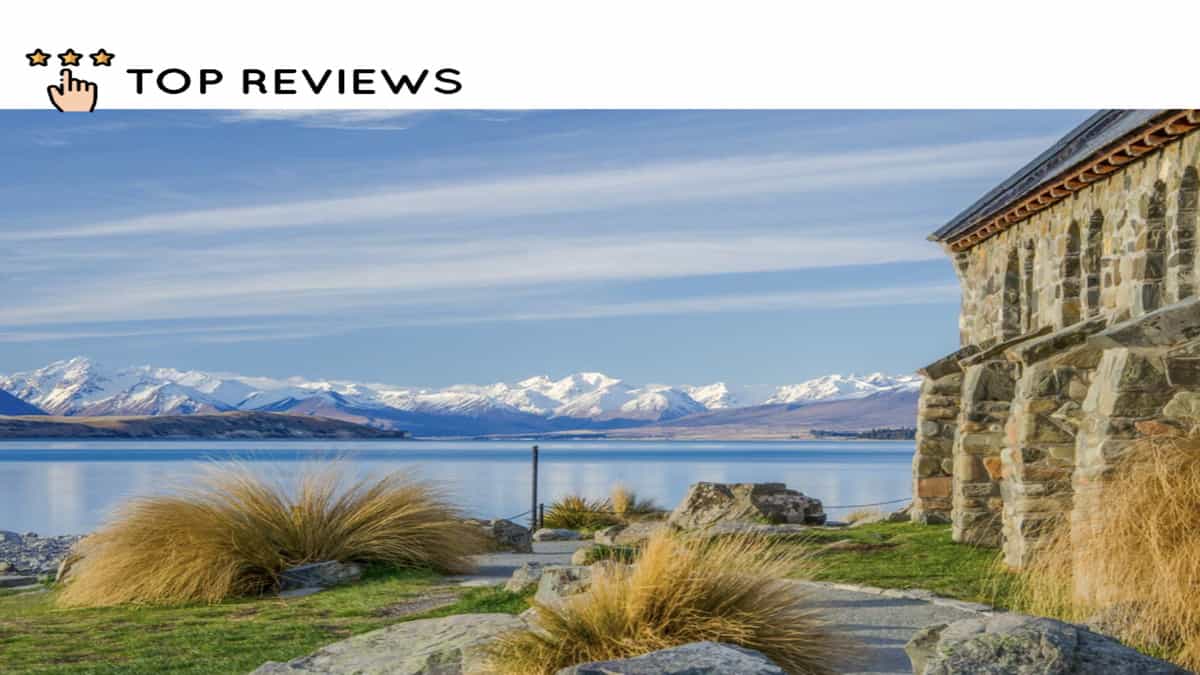Where should I stop between Lake Tekapo and Queenstown? (The Best Sights!)
The drive from Lake Tekapo to Queenstown is full of crystal-clear lakes, and pristine alpine mountains. With so much to see, it can be difficult to know where you should stop for a little break!
That’s why we’re here today. We’ve voted on our favourite stops and compiled a list together to help you know where you should stop along the route of Lake Tekapo to Queenstown!
The Church of the Good Shepherd
Distance from Lake Tekapo: 550 m
Distance from Queenstown: 257 km
Website: Church of the Good Shepherd
Address: Pioneer Drive, Lake Tekapo 7999, New Zealand
Hours: Monday to Sunday – 9 AM to 5 PM
This rustic church not only has stunning views of the Southern Alps but also serves as a serene space for quiet reflection, making it an unforgettable destination for both nature enthusiasts and those seeking a peaceful retreat. Plus, the unique stone architecture is charming and adds to the ambience.
But for a really unique perspective of the Church of the Good Shepherd, try to visit during winter when snow blankets the grounds, transforming it into a serene, fairytale-like setting.
Pro Tip
- Early morning visits are the best. You’ll avoid the crowds, have a peaceful time, and capture stunning sunrise photos.
Lake Tekapo Regional Park
Distance from Lake Tekapo: 1.2 km
Distance from Queenstown: 257 km
Website: Lake Tekapo Regional Park
Address: https://maps.app.goo.gl/LcSA18HeSvabUvsm9?g_st=ic
Hours: Open 24 hours
There is sooo much to do at Lake Tekapo Regional Park. We never grow bored when we come here.
From walking and cycling trails, swimming, and picnicking to taking Insta reels and Tiktoks of the turquoise lake, vibrant lupin fields, and dramatic Southern Alps—you’re bound to enjoy your pit stop.
Pro Tip
- Bring a blanket and some snacks and chill out by the lake with a book or some music!
Tekapo Springs
Distance from Lake Tekapo: 2.2 km
Distance from Queenstown: 257 km
Website: Tekapo Springs
Address: 300 Lakeside Drive, Lake Tekapo 7945, New Zealand
Hours:
- Monday to Friday – 11 AM to 7 PM
- Saturday & Sunday – 10 AM to 7 PM
Pricing:
Relaxing in the hot pools and enjoying the view of Lake Tekapo is definitely at the top of our list of ways to unwind on a break—especially after a long drive.
Tekapo Springs’ unique combination of hot pools, day spa treatments, and thrilling waterslides, caters to visitors of all ages seeking both tranquillity and adventure.
Pro Tip
- Although the hot pools are a delight during the day, we suggest immersing yourself in the soothing waters at night under a blanket of glittering stars. If you’re lucky, you might be able to spot some constellations.
Mount Cook National Park
Distance from Lake Tekapo: 104 km
Distance from Queenstown: 263 km
Website: Mount Cook National Park
Address: https://maps.app.goo.gl/7xxN6eJpk7NQmHaG8?g_st=ic
It’s no lie that the beauty of Mount Cook National Park is undeniable, and every angle is worth capturing. Moreover, there are many picturesque hiking trails, guided glacier walks, and world-class stargazing at the Aoraki Mackenzie International Dark Sky Reserve.
Pro Tip
- Take a scenic helicopter flight to experience the jaw-dropping views of Mount Cook and its glaciers. Also, make sure to book your activities and accommodation in advance as it gets busy during the peak season!
Tasman Glacier Viewpoint
Distance from Lake Tekapo: 110 km
Distance from Queenstown: 268 km
Address: https://maps.app.goo.gl/YUvXD8MbZp1WUxzv8?g_st=ic
Hours: Open 24 hours
Pausing your road trip for a visit to the Tasman Glacier Viewpoint is an opportunity you won’t want to miss!
The easy walk to the viewpoint lets you stretch your legs and allows you to marvel at the awe-inspiring beauty of the glacier and its striking glacial lake, enveloped by the grandeur of Mount Cook National Park.
Pro Tip
- Keep an eye out for cheeky kea birds, the world’s only alpine parrot!
Sir Edmund Hillary Alpine Centre
Distance from Lake Tekapo: 104 km
Distance from Queenstown: 263 km
Website: Sir Edmund Hillary Alpine Centre
Address: https://maps.app.goo.gl/r3ZYxGnJXHxLWMWMA?g_st=ic
Hours: Monday to Sunday – 9 AM to 5 PM
Step into the world of legendary adventurers at the Sir Edmund Hillary Alpine Centre—where you can uncover the rich history behind New Zealand’s mountaineering triumphs.
As you explore the exhibits, you’ll feel the thrill of scaling Mount Cook through the eyes of Sir Edmund Hillary himself. Our favourite experiences in the museum are the 3D planetarium and the cinema!
Pro Tip
- Plan to visit during the daytime for the history exhibits and at night for stargazing.
Lake Pukaki Viewpoint
Distance from Lake Tekapo: 47 km
Distance from Queenstown: 209 km
Address: 5098 Tekapo-Twizel Road, Ben Ohau 7999, New Zealand
Hours: Open 24 hours
You’ve probably seen pictures of this place on your social media feed. It’s a place that is always worth a visit, no matter what—with brilliant turquoise water, stunning mountains, and an awe-inspiring natural beauty that fills your heart and soul.
Pro Tip
- Try to time your visit during the lupin bloom (from mid-November to late December) when vibrant flowers frame the turquoise lake and paint a breathtaking scene.
Lindis Pass Scenic Reserve
Distance from Lake Tekapo: 119 km
Distance from Queenstown: 137 km
Website:
Address:
Hours:
Lindis Pass Scenic Reserve has a panoramic view of the sweeping tussock-covered hills and valleys, making it an ideal spot for photography enthusiasts and nature lovers alike.
Taking a moment to pause and soak in the serenity of this unique location will leave you feeling refreshed and inspired as you continue your journey.
Pro Tip
- Pack a picnic lunch, and stop at the reserve for a breathtaking view and fresh air.
Ahuriri Valley
Distance from Lake Tekapo: 118 km
Distance from Queenstown: 165 km
Address: https://maps.app.goo.gl/zqe7ANF6Xpb2m4DV8?g_st=ic
Ahuriri Valley’s untouched landscape boasts dramatic mountain ranges, crystal-clear rivers, and vast tussock grasslands teeming with native flora and fauna. There are plenty of hiking, fishing, and birdwatching opportunities too!
Pro Tip
- Read up on the safety protocols for fishing excursions beforehand.
Wanaka
Distance from Lake Tekapo: 199 km
Distance from Queenstown: 68 km
Address: https://maps.app.goo.gl/rYjv1kn5sFYX6AKr6?g_st=ic
Stopping at Wanaka during your road trip is a must, as this picturesque town offers a perfect blend of relaxation and outdoor adventure with hiking, biking, and water sports. Wanaka is also home to charming cafes, restaurants, and boutique shops.
Pro Tip
- Try some local beer at the Rhyme & Reason brewery!
Cromwell
Distance from Lake Tekapo: 197 km
Distance from Queenstown: 59 km
Address: https://maps.app.goo.gl/EPTFG1td5JxXLoKv5?g_st=ic
Cromwell has a thriving foodie scene, with abundant artisanal produce, boutique breweries, and farm-to-table restaurants. It’s a foodies paradise!
Pro Tip
- Visit the Cromwell Heritage Precinct, where you can see some of the town’s heritage buildings, including former flour mills.
Gibbston
Distance from Lake Tekapo: 228 km
Distance from Queenstown: 28 km
Address: https://maps.app.goo.gl/eF3z9tKHuhogCF9M7?g_st=ic
The valley of Gibbston is famous for its vineyards, wineries, and wine tastings. It’s a perfect place to relax, enjoy the magnificent view, and try some of the best wines in New Zealand.
Don’t forget to stop at the Gibbston Valley Cheesery, their cheese pairs deliciously with Gibbston’s superb wines!
Pro Tip
- If you’re not feeling like dining on wine and cheese, hire a bike and explore the Gibbston River Trail to see some of the beautiful countryside.
Arrowtown
Distance from Lake Tekapo: 243 km
Distance from Queenstown: 20 km
Address: https://maps.app.goo.gl/S2uQZWcDrWJkTw1Z7?g_st=ic
Arrowtown takes you back to the gold rush era of the 1800s. We love the ambience of its quaint streets, lined with restored colonial buildings, boutique shops, and restaurants.
There’s more to this town than the historical aspect—set out on their hiking and biking trails, or try your hand at golfing.
Pro Tip
- Visit the bakery and try some of their pies, pastries, and famous custard squares.



